What you need to know about the Omicron wave today
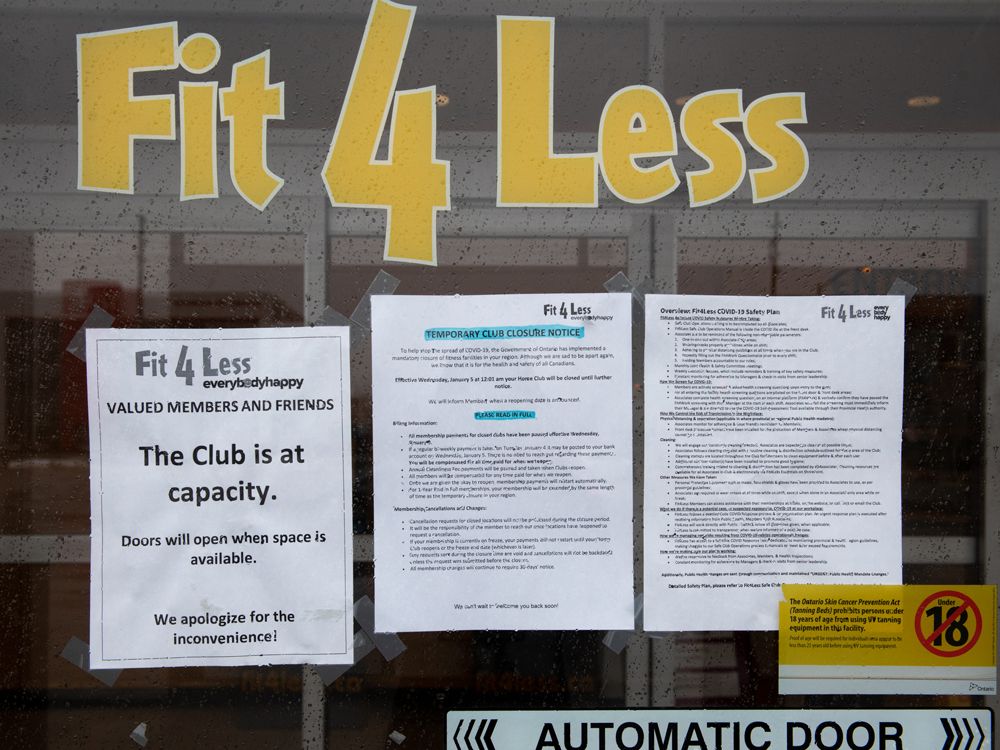
Omicron’s rapid spread is bringing new restrictions and concerns daily. Get the latest news here
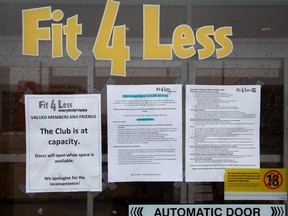
Article content
The rapid spread of the COVID-19 variant Omicron across Canada brings more restrictions, curtailments of services and concerns about shortages daily.
Advertisement
Story continues below
This advertisement has not loaded yet, but your article continues below.
Article content
Read below for our blog rounding up the latest news on the Omicron outbreaks as it happened on Thursday.
4:30 p.m.
Canada’s main stock index rebounded as higher crude oil prices powered the energy sector while a hawkish tone from the U.S. Fed took the shine off gold. Investors continued to look past the continued surge in COVID-19 cases.
The S&P/TSX composite index closed up 32.54 points to 21,072.20.
In New York, the Dow Jones industrial average was down 170.64 points at 36,236.47. The S&P 500 index was down 4.53 points at 4,696.05, while the Nasdaq composite was down 19.30 points at 15,080.87.
The Canadian dollar traded for 78.49 cents US compared with 78.63 cents US on Wednesday.
— The Canadian Press
3:50 p.m.
Cineplex Inc. is temporarily laying off 6,000 part-time employees due to mandated closures of its venues amid surging COVID-19 cases, the Canadian cinema operator said on Thursday.
Advertisement
Story continues below
This advertisement has not loaded yet, but your article continues below.
Article content
Due to mandated closures of Cineplex’s theatres and entertainment sites across Ontario and Quebec, the company had yet again decided to temporarily lay off its part-time workforce, Cineplex spokeswoman Sarah Van Lange said. Cineplex had taken similar actions for all provincial government mandated closures earlier since the pandemic began, she added.
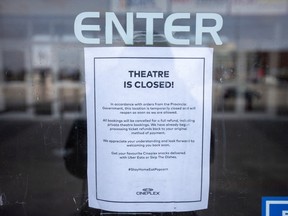
Out of the 6,000 workers being laid off, 5,000 are in Ontario.
The cinema industry has been one of the worst affected sectors by the pandemic, with lockdowns shutting cinemas and delaying movie releases at a time when the industry has been trying to stave off increased competition from streaming services. In December, the 2019 planned acquisition of Cineplex by British cinema operator Cineworld was scrapped.
Advertisement
Story continues below
This advertisement has not loaded yet, but your article continues below.
Article content
— Reuters
2:45 p.m.
Last month, a number of central banks turned more hawkish at their year-end meetings as the global economic recovery picked up speed, inflation surged and Omicron was just beginning to unleash its wrath. The Bank of England became the first central bank in the G7 to raise interest rates. The U.S. Federal Reserve accelerated its tapering. And the Bank of Canada conceded inflation was becoming an issue worth keeping a close eye on.
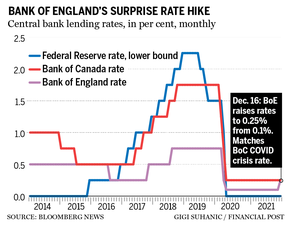
Particularly in Canada, Omicron was barely a blip on the radar when the bank had its Dec. 8 meeting. Now, case counts are breaking daily records and more people are calling in sick, even as provinces impose capacity restrictions to limit spread.
“The question is whether central banks will continue to look through Omicron risks in early 2022,” Josh Nye, senior economist at Royal Bank of Canada, wrote in a note to clients Thursday.
Advertisement
Story continues below
This advertisement has not loaded yet, but your article continues below.
Article content
Canada’s economy showed considerable strength in the last half of 2021. Third quarter gross domestic product stood at 5.4 per cent, annualized, and the beginning of the fourth quarter started off strong, coming in at 0.8 per cent in October. By the fall, the labour market had recovered the major pre-pandemic losses.
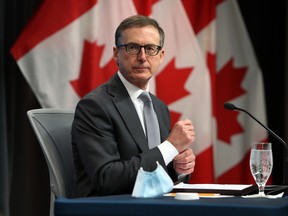
Data that would provide a temperature check will come in the next few weeks but until then, most economists, including Nye, suspect that Omicron will be a bump in the road of the economic recovery. With its next meeting on Jan. 26, governor Tiff Macklem and his deputies will be the first to convene among major economies, providing a “litmus test” on how other central banks will respond to Omicron, Nye said.
Advertisement
Story continues below
This advertisement has not loaded yet, but your article continues below.
Article content
“Even with containment measures set to slow Canada’s recovery early this year, we think the BoC will lean hawkish in January and lay the groundwork for near-term rate increases,” he said.
— Bianca Bharti, Financial Post
1:41 p.m.
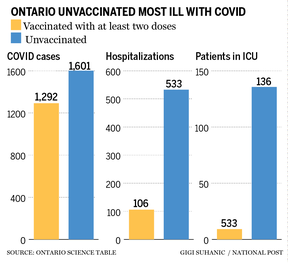
Hospitalizations in some parts of Canada are spiking as Omicron takes hold.
On Dec. 1, Ontario had 296 hospitalized COVID-19 patients. On Jan. 6, Canada’s most populous province reported 2,279 hospitalizations.
Quebec has seen a similar spike. At the start of December, 239 Quebeckers were hospitalized because of the virus. Today, there are 1,953 in hospital.
Alberta currently has 470 hospitalizations, according to the provincial website, not far off from where it was on Dec. 1, at 426. However, it’s important to note that Alberta had been seeing cases decline from a peak of more than 1,000 hospitalizations at the end of September and beginning of October to a low on Dec. 18 of 323. Since then hospitalizations have started to pick up again.
Advertisement
Story continues below
This advertisement has not loaded yet, but your article continues below.
Article content
Because Omicron so far appears to be less severe than other variants of COVID-19, everyone from politicians to doctors are keeping a close eye on hospitalizations and ICUs to monitor the strain on healthcare systems.
Below are the ICU numbers for the three provinces.
Ontario:
Dec. 1, 2021: 139
Jan. 6, 2022: 307
Alberta:
Dec. 1, 2021: 78
Jan. 6, 2022: 72
Quebec:
Dec. 1, 2021: 52
Jan. 6, 2022: 207
— Bianca Bharti, Financial Post
1:19 p.m.
You will have to show proof of vaccination against COVID-19 to enter liquor and cannabis stores in Quebec starting Jan. 18.
Health Minister Christian Dube said today that he introduced the new rules because the province owns and operates these outlets and he would announce more services and businesses where the vaccine passport will be required soon.
Advertisement
Story continues below
This advertisement has not loaded yet, but your article continues below.
Article content
Dube hinted that these might be shopping malls and personal care salons.
“If they won’t protect themselves, we’ll protect them from themselves,” Dube told reporters in Montreal, referring to people who haven’t had a single dose of COVID-19 vaccine.
1:05 p.m.
COVID-19 outbreaks have been reported at nearly 30 per cent of long-term care homes in Ontario, which are already dealing with staff absences of 20 to 30 per cent.
Ontario minister Rod Phillips said today there are outbreaks at 186 homes and he expects the number to rise.
Some facilities are recruiting fast food workers to fill in for kitchen staff who off are work sick, said a union official.
12:30 p.m.
The bad news about the rapid spread of Omicron is offset by good news about how fast the economy was growing at the end of the 2021.
Advertisement
Story continues below
This advertisement has not loaded yet, but your article continues below.
Article content
November was supposed to be a bad month for exports, given how the country’s most important port had been cut off from the rest of the country for several days by epic floods in British Columbia. Yet as Bianca Bharti reports , merchandise exports still jumped almost four per cent from October.
The economy has/had momentum. How much momentum? Rather than wait months for Statistics Canada to complete its quarterly tallies of gross domestic product, Bank of Nova Scotia gathers data in real time to produce a nowcast of the annual rate of growth in the most recent quarter. The surprisingly strong trade numbers pushed that dial to 6.2 per cent for the fourth quarter. That would be beat the third-quarter rate of 5.4 per cent and would be the strongest since the final three months of 2020.
Advertisement
Story continues below
This advertisement has not loaded yet, but your article continues below.
Article content

“It is safe to say that the feared collapse in trade failed to materialize,” said Nikita Perevalov, director of economic forecasting at Scotia. “This means that the economy entered into the Omicron holiday season with slightly more strength than we anticipated.”
Data from the fall have little bearing on the current situation: Perevalov described the outlook for January as “bleak.” Still, all things equal, the bleakness will be short lived. Last winter’s COVID-19 wave cause an economic contraction in the spring. That might not happen this time.
— Kevin Carmichael, Financial Post
11:48 a.m.
The pandemic housing frenzy continued in Canada in 2021, data out today confirmed.
Two of Canada’s most expensive housing markets hit record home sales.
Advertisement
Story continues below
This advertisement has not loaded yet, but your article continues below.
Article content
A record 121,712 homes were sold in Toronto, up 7.7 per cent from the previous high in 2016, the Toronto Regional Real Estate Board said Thursday.
In Vancouver 43,999 homes were sold, up 42.2 per cent from the year before and up four per cent from the previous record set in 2015, according to the Real Estate Board of Greater Vancouver.
“Extremely tight market conditions” drove Toronto’s average selling price to $1,095,475 – up 17.8 per cent from the previous record in 2020, said TRREB.
The benchmark home price in Vancouver rose to $1.23 million, 17 per cent higher than in December 2020.
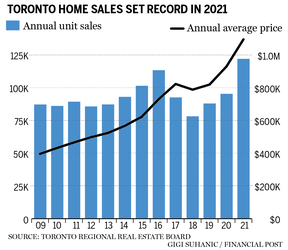
And tight supplies of housing mean prices aren’t going down any time soon in either city.
Vancouver starts the year with just over 5,000 homes for sale in the region, the lowest inventory in more than 30 years.
Advertisement
Story continues below
This advertisement has not loaded yet, but your article continues below.
Article content
“With demand at record levels, residents shouldn’t expect home price growth to relent until there’s a more adequate supply of housing available to purchase,” said Keith Stewart, Vancouver board economist.
11:37 a.m.
Canada’s Recovery Tracker fell for the sixth time in seven weeks last month as health conditions and sentiment deteriorated because of the growing Omicron wave sweeping the country. The health index on Oxford Economics’ tracker, seen below, plunged 16.6 percentage points to its lowest since May 2021. The sentiment index dropped 7.2 percentage points.
Have a look at the Financial Post’s economy tracker here.
9:59 a.m.
Surging cases of COVID-19 driven by the rapidly transmissible Omicron variant are pushing the health-care system to the brink and putting pressure on some police and transit services, the Canadian Press reports.
Advertisement
Story continues below
This advertisement has not loaded yet, but your article continues below.
Article content
The Winnipeg Police Service declared a state of emergency Wednesday after 170 staff booked off on leave related to COVID-19. Edmonton and Calgary police services also warned of staffing challenges from employees testing positive or going into isolation.
Ontario’s GO Transit said it will begin a temporary reduction in train and bus service in the Greater Toronto and Hamilton areas within days because of staffing shortages caused by the virus.
9:41 a.m.

The infamous Sunwing party passengers, who filmed themselves in unmasked revelry on a charter flight from Montreal to Mexico last week may find themselves stranded.
Sunwing Airlines cancelled their return flight from Cancun scheduled for Wednesday. Now Air Transit and Air Canada have said they too refuse to carry the passengers.
Advertisement
Story continues below
This advertisement has not loaded yet, but your article continues below.
Article content
Even Prime Minister Justin Trudeau weighed in calling the partiers “idiots.”
Videos of the Dec. 30 flight shared on social media show passengers not wearing masks and singing and dancing in the aisle and on seats. In one video, a large bottle of vodka appears to be passed among passengers, and later a woman appears to be smoking an electronic cigarette.
One passenger, who won the free trip in a contest on Instagram, told Canadian Press she has tested positive for COVID-19 and estimates that about 30 others on the flight have also tested positive.
9:23 a.m.
The Ontario government is expected to provide an update today on the deployment of rapid antigen COVID-19 tests in the province.
The update comes a day after the federal government said it will distribute 140 million rapid tests across the country this month — four times the amount handed out in December.
Advertisement
Story continues below
This advertisement has not loaded yet, but your article continues below.
Article content
9:00 a.m.
Canada’s trade surplus widened to $3.1 billion in November from $2.3 billion in October, further evidence that the economy built up momentum heading into the Omicron wave.
Total exports increased 3.8 per cent to $58.6 billion largely due to large shipments of COVID-19 medication coming in to the country for labelling and packaging to be shipped back out, Statistics Canada reported Thursday. That same phenomenon also contributed to record high levels of imports, which grew to $55.4 billion in November.
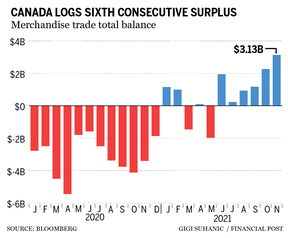
The positive data will ease concerns surrounding the impact of unprecedented floods and landslides in British Columbia to Canada’s overall trade balance. Still, the weather-inflicted damage caused a 7.8 per cent drop in goods exported from the province.
Economists suspect the clean-up and rebuilding in British Columbia should bolster growth for the last few months of 2021 and into 2022. This would help support the economy as it grapples with the surge in cases of the COVID-19 variant Omicron.
— Bianca Bharti, Financial Post
With additional reporting by Canadian Press
Advertisement
Story continues below
This advertisement has not loaded yet, but your article continues below.





